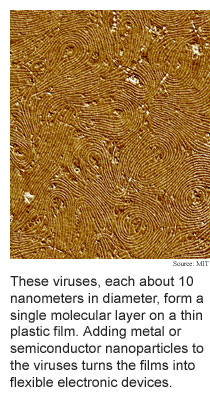
February
20, 2006
High-tech
virus films
Nature is proving to be a particularly versatile resource for
finding simple, inexpensive ways of building high-tech materials and devices.

Researchers from the Massachusetts Institute of Technology have
advanced their technique of using viruses to build
extremely thin films of material molecule-by molecule by engineering a
bacteria-invading virus to form rigid rods, using electrostatic forces
to make the virus rods line up in a single layer, and then covering the
viruses with metal or semiconductor nanoparticles, or encapsulating them
to form nanowires.
The researchers formed the virus layers on top of flexible plastic
films that can be made as thin as 10 nanometers. The method taps inexpensive
chemical fabrication techniques that can be used with a wide variety of
materials that have useful electronic, magnetic and optical properties.
The virus-coated films could be used to make chemical and biological
sensors and electronic devices like lightweight, flexible electrodes for
batteries, solar cells and light-emitting diodes.
(Spontaneous Assembly of Viruses on Multilayered Polymer Surfaces,
Nature Materials, published online February 19, 2006)
Rubber crystal has light touch
Photonic crystal -- material with tiny regularly spaced holes
-- precisely controls lightwaves, opening the way for lightning fast computer
chips that use light rather than electrical signals and tiny communications
devices.
Researchers from the University of Toronto and the European Laboratory
for Non-linear Spectroscopy have given the concept of photonic crystal
a twist.
They have made photonic crystal from rubber, which means the crystal's
light-controlling properties can be reversibly changed by stretching and
compressing the crystal.
The rubber photonic crystal could be used to make optical devices
that are sensitive to pressure. Potential applications include highly-accurate
color fingerprinting, color displays, air-bag sensors, building strain
sensors, and tunable light-emitting diodes and lasers.
(From Colour Fingerprinting to the Control of Photoluminescence
in Elastic Photonic Crystals, Nature Materials, published online
February 19, 2006)
Bits and pieces
Enzymes compute
The right combination of enzymes, hydrogen peroxide, and glucose
forms a chemical
computer that carries out basic binary logic functions. The method
could be used to monitor biochemical processes and to make high-speed
hybrid chemical-electronic computers.
(Elementary Arithmetic Operations by Enzymes: A Model for Metabolic
Pathway Based Computing, Angewandte Chemie International Edition,
February 27, 2006)
Quantum crypto advances demoed
A pair of upcoming papers demonstrate promising methods for simplifying
and improving quantum cryptography systems. One method uses a photon's
position within an array of pixels to transmit 4.5 bits of information
per photon rather than just one. The other method uses decoy
signals to detect eavesdroppers.
(Quantum Key Distribution with Higher-Order Alphabets Using Spatially
Encoded Qudits, Experimental Quantum Key Distribution with Decoy States,
scheduled for publication in Physical Review Letters)
Swollen lenses make biosensor
Microscopic hydrogel
lenses change size, and thus focus, in the presence of specific amounts
of antibodies. The lenses promise to be sensitive biosensors for diagnosing
diseases and developing drugs.
(Label-Free Biosensing with Hydrogel Microlenses, Angewandte
Chemie International Edition, February 20, 2006)
Nanofluidics tune light chips
A combination of nanoscale fluidic
channels and photonic crystal -- materials that contain tiny, regularly
spaced holes -- makes a material that can be filled with liquid in order
to change its lightwave-controlling properties. The technique could be
used to make chemical and biological sensors that can detect and analyze
individual molecules and optical communications devices that can be reconfigured
on-the-fly.
(Nanofluidic Tuning of Photonic Crystal Circuits, Optics Letters,
January 1, 2006)
RSS Feeds: News Blog Books New: TRN's Internet Services TRN's Jobs Center News: Research News Roundup Research Watch blog Features: View from the High Ground Q&A How It Works Buy an ad link |
|
| Advertisements: |
|
Ad links: Clear History
Buy an ad link
|
TRN
Newswire and Headline Feeds for Web sites
|